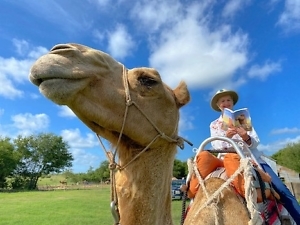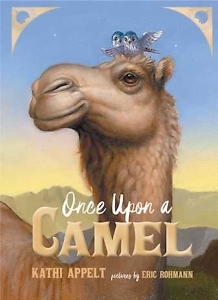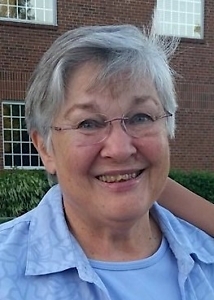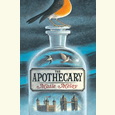As the Story Goes
Kathi Appelt delivers an epic tale of camels, kestrels, and the power of stories
Once Upon a Camel, Kathi Appelt’s newest novel for young readers, is ambitious, to say the least. It’s the story of Zada, a camel who lives in the foothills of West Texas in the year 1910. When a mighty dust storm strikes and Zada’s kestrel friends are whisked away, she lodges their chicks atop her head, sets out to find their parents, and pledges to keep them safe.
 To distract them from the dangers that surround them, not the least of which is the violent storm, Zada tells the kestrels stories of her past. Her namesake, after all, is none other than Scheherazade, one of literature’s most legendary storytellers. And what a colorful past it is, one that begins in 1850 with her life as a racing camel in Smyrna, Turkey, living under the gentle instruction of a pasha named Teodor. How Zada and her constant companion, another camel named Asiye, made their way to the United States is just one of the many compelling stories Zada has to tell about her fascinating life.
To distract them from the dangers that surround them, not the least of which is the violent storm, Zada tells the kestrels stories of her past. Her namesake, after all, is none other than Scheherazade, one of literature’s most legendary storytellers. And what a colorful past it is, one that begins in 1850 with her life as a racing camel in Smyrna, Turkey, living under the gentle instruction of a pasha named Teodor. How Zada and her constant companion, another camel named Asiye, made their way to the United States is just one of the many compelling stories Zada has to tell about her fascinating life.
Chapter 16 asked Appelt via email about the novel, which includes illustrations from Caldecott Medalist Eric Rohmann.
Chapter 16: You mention in the closing author’s note that your grandfather once told you, as a child, that there were wild camels in West Texas and that, as an adult, you decided to research that. Was that the initial spark for this story?
Kathi Appelt: Yes, as a youngster I just accepted that there were camels in West Texas, because if my grandfather said it was so, well, it must be so. Nevertheless, I never actually saw any out there, with the exception of a lone camel that grazed in a tiny pen next to one of those roadside attractions that featured “Beasts of the Bible.” Or something like that. I guess there was a donkey somewhere, but I only had eyes for that imposing dromedary. Obviously, that camel wasn’t wild. It also wasn’t in West Texas. It was in north Houston.
The other thing to note is that my father was a dedicated cigarette smoker, and his brand of choice was Camels. Unfiltered. I remember being enchanted by the camel image on the pack. Remember those?
So, I think I have a bit of a sweet connection to camels. They call up my dad and granddad. Still, it wasn’t until recently that I actually asked why there might be camels in Texas. That’s when I discovered the project that the U.S. Army embarked upon in the mid-19th century, in which they imported several dozen camels to use as pack animals to cross the southwestern desert and mountain ranges.
Interestingly, the man who really championed the project turned out to be Jefferson Davis, and that suddenly explained my grandfather’s awareness of them. He was something of an amateur historian, and he was especially interested in the American Civil War. I’m sure he must have stumbled across the camels in his reading, considering their connection to Davis.
Chapter 16: You must have done a great deal of research for this book — not just about the presence of camels in Texas at the turn of the last century but also racing camels in Smyrna, weather events (like haboobs), the Turkish language, the relationship between the Turkish government and the U.S. Army in the late 1800s, Conquistadors in the mid-16th century, and much more. Do you enjoy such research-driven writing?
Appelt: I love the research side of my work. In fact, if I’m not careful, research would definitely get the better of me. You’d be surprised at how much information I took out of this story. It turns out that what makes me delirious with happiness is actually a form of info-dumping that doesn’t really move the story forward. But beware, if you’re ever having a glass of wine with me and you ask me a question about those camels, well, let’s just say, it could be a long night.
In regard to the Turkish content, I was extremely lucky to find a reader who kept me honest when it came to both the linguistics and the content. She’s a Ph.D. student at Texas A&M in nuclear engineering. I loved working with her.

Chapter 16: Did you hang out, by chance, with real camels for the purposes of research?
Appelt: Of course! Early on, before I had a single word on the page, my daughter-in-law, Laurel Kathleen, arranged for us to visit the Oasis Camel Dairy near San Diego. There’s a day I’ll always remember. More recently, I got to visit Doug Baum and his camel, Richard. Doug is the most recent expert on the historic U.S. Camel Corps.
Chapter 16: The language in this book is especially evocative — words like “rowdydow” (perfect for two tiny kestrel chicks) and the sensory language you created to capture the world of these birds. Was it a challenge to keep the birds’ lexicon, if you will, consistent as you wrote the story?
Appelt: Finding a character’s true voice is always a challenge, and that was certainly the case for me when it came to Zada. She’s the primary narrator for sure. And it took me some time, and several drafts, to really nail down her voice. She had to carry a heavy load.
The little kestrels were easier. For one thing, they were so feisty, so full of life, that writing them was a true source of joy for me. In fact, at one point I decided that the mantra for this story was “give joy a chance.” While I worked, the pandemic was in full force, and I found myself struggling to get words on the page. Did it matter? A story about an old camel and a family of falcons? There were some days that I felt somewhat bereft, and I think the writing reflected that. At last, in order to keep things from seriously devolving into the blues, I turned to that mantra. And the birdlings were a great way to keep that phrase present in my mind.
Chapter 16: The moment we flash back to Asiye’s and Zada’s farewell is moving. Was that difficult to write?
Appelt: Let’s just say that I went through several boxes of Kleenex.
 Chapter 16: You’ve written this compelling book about the power of story. Is there an example from your own life you’d like to share about the impact of a powerful story?
Chapter 16: You’ve written this compelling book about the power of story. Is there an example from your own life you’d like to share about the impact of a powerful story?
Appelt: I had the great fortune of growing up amidst storytellers. My grandmothers and my mom knew how to spin a yarn. Yes, the men in my family could tell a tale too, but not with the same gusto and wonder as the women. Put those spinners together in a room, and soon enough the air would turn all sorts of varying colors. So wonderful.
But I think, perhaps, the thing that made me a true believer in the power of story was my experience with Al-Anon. For a while I attended those meetings regularly, thanks to our family’s concentration of alcoholics. (That’s its own story, I tell ya.) But one night, long after the meeting ended, it just occurred to me that it wasn’t the Steps that mattered so much as the stories. It was the shared experiences, the sacred space, the courage and bravery that the tellers had to tap into in order to share, especially things that were intensely personal, that really drove into me how important stories were, how necessary it was to share them. They saved us. We saved each other.
I think of Story as the benevolent goddess, the one who will laugh and cry with you, so long as you dig deep, tell the truth as you know it, and then pass it along.
Chapter 16: What do you think Eric Rohmann’s illustrations bring to this story, and which painting is your favorite?
Appelt: Could there be anyone better for bringing this story to life than Eric? I feel so enormously fortunate that he said yes to this project. As soon as he did, he sent me a photo of him and [Candace Fleming] astride a pair of camels. That seemed like a sign (maybe from the aforementioned goddess). Also, and here’s something important, when you take a good look at a camel’s face, they seem to be subtly smiling, as if joy is their way of moving through this old world. So, when the art began to arrive, I noticed it straightaway. Joy. Yes, right there. Eric caught it.
Can I choose a favorite? Why, yes. Yes, I can. It’s that final spread where Zada is gazing into the beautiful night sky. Right there, I feel the richness of life, the vast spread of the universe, and an overpowering presence of love.
Chapter 16: Tell us about your Southern Festival of Books visit. Yours will be virtual, yes?
Appelt: I don’t have all the details yet, but yes, mine will be virtual. Alas! I miss being present, in person, and the Southern Fest is so special. The first time I came, I was with Arthur Howard. We were launching our picture book, Bubba and Beau, Best Friends. So, that was a while ago. I’ve been there since then, and I hope I get to return. Surely. Surely, we’ll get past this pandemic before the next one rolls around. Get your shots, everyone!

Julie Danielson, co-author of Wild Things! Acts of Mischief in Children’s Literature, writes about picture books for Kirkus Reviews, BookPage, and The Horn Book. She lives in Murfreesboro and blogs at Seven Impossible Things Before Breakfast.





